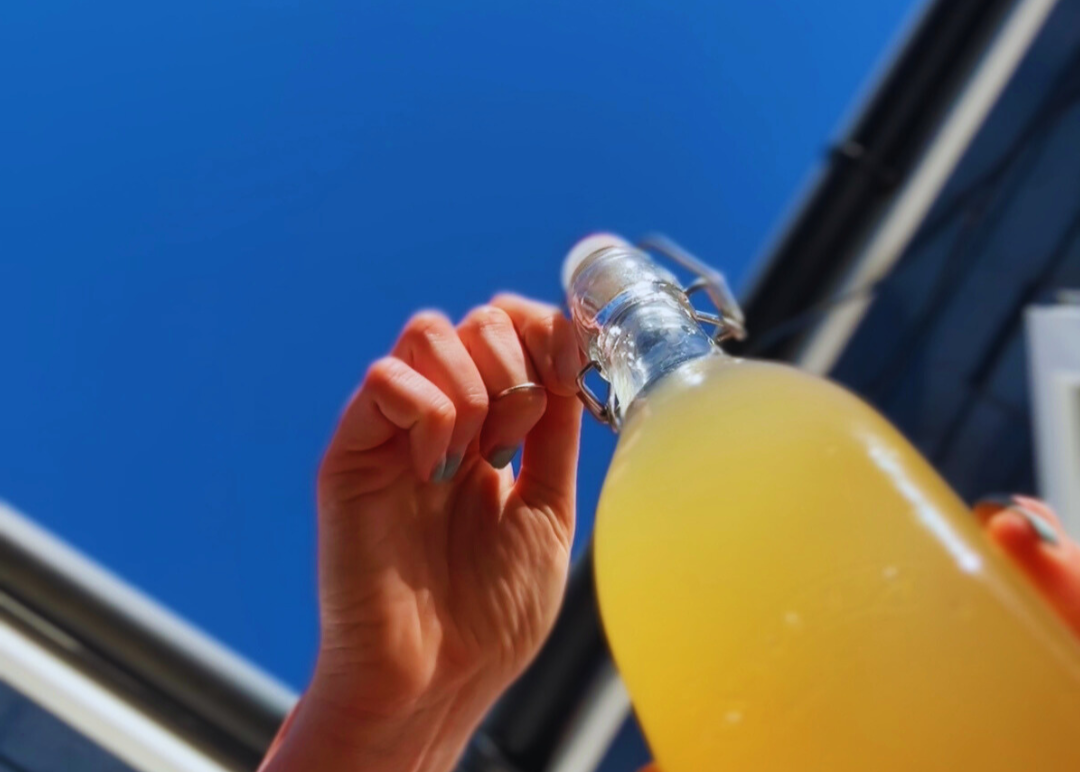Blood sugar spikes after meals are something many of us experience, and many health experts report that frequent spikes can be very damaging to our health.
Research has been exploring natural ways to help balance and control blood glucose levels, and fermented drinks like Kombucha are gaining attention as a promising, affordable option that actually tastes delicious.
While apple cider vinegar (ACV) has long been recognised for its blood sugar benefits, Kombucha may offer a more palatable approach thanks to its probiotics, polyphenols, and organic acids.
If you're looking to get ahead and start making your own Kombucha, we are famous for our Kombucha Starter Kits, which promise perfect Kombucha to even the busiest, most-useless-in-the-kitchen, space poor people.
If you've never tried a totally authentic, natural Kombucha, then order one of our sample bottles here, for just the cost of postage.

What is Kombucha?
Kombucha is made by fermenting sweet tea with a symbiotic culture of bacteria and yeast (often called a SCOBY). During fermentation, the sugar in the tea is consumed by microbes and converted into organic acids, traces of ethanol (alcohol), carbon dioxide, and other beneficial compounds.
The end result is a tart, lightly fizzy beverage that can be brewed to taste mild and slightly sweet or very tangy and vinegar-like depending on how long it ferments. It’s this fermentation process that may also hold benefits for blood sugar regulation.
Evidence from Recent Studies
Recent studies have begun to investigate Kombucha’s effects on people with type 2 diabetes.
In a 2023 randomised, double-blinded, crossover trial, 12 participants with type 2 diabetes consumed either 240 ml of Kombucha or a placebo daily for four weeks. The study found that Kombucha significantly lowered average fasting blood glucose levels from 164 mg/dL to 116 mg/dL (p = 0.035), while the placebo had no significant effect.
For participants with baseline fasting glucose above 130 mg/dL, the drop was even more striking, averaging a reduction of 74 mg/dL compared to just 16 mg/dL in the placebo group. This was one of the first controlled human studies to show Kombucha’s potential for blood sugar regulation (Frontiers in Nutrition, 2023; PubMed ID 37588049).
Animal research has also provided supporting evidence. In diabetic rats, Kombucha has been shown to inhibit alpha-amylase activity, which slows the breakdown of starch into glucose, leading to smaller blood sugar spikes after meals. It has also been observed to improve pancreatic function and enhance antioxidant defences, which may reduce oxidative stress associated with diabetes (PubMed ID 22591682).
These studies, while preliminary, suggest Kombucha’s unique mix of acetic acid, lactic acid, probiotics, and polyphenols from the tea may work together to support glucose control.

Apple cider vinegar, in comparison, has a stronger research base and is known for its acetic acid content. Acetic acid has been shown to slow gastric emptying, reduce carbohydrate absorption, and improve insulin sensitivity, leading to smaller post-meal glucose and insulin spikes.
Multiple clinical trials and meta-analyses have supported vinegar’s modest but consistent benefits in both healthy people and those with impaired glucose metabolism. In type 2 diabetes, daily intake of 15-30 ml of ACV has been associated with reductions in fasting blood glucose and haemoglobin A1C, along with improvements in cholesterol levels.
The drawback of ACV is the taste. Very few enjoy its tangy punch, many find drinking diluted vinegar unpleasant, and frequent use can cause dental enamel erosion or digestive irritation.
This is where Kombucha has a distinct advantage. Long-fermented Kombucha shares some of the acetic acid benefits of vinegar but comes wrapped in a much more enjoyable, tasty package.

Light carbonation, and added spices or herbs can turn a strong fermented Kombucha into a drink people actually look forward to consuming, making it much more likely to stick as a daily habit.
The Length of Fermentation Factor
The fermentation length plays a big role in Kombucha’s impact.
A shorter fermentation of 7 to 10 days produces a sweeter, milder beverage with slightly more residual sugar. This is perfect for anyone looking for the probiotics, anti-oxidants, and for some organic acids (and blood sugar balancing help), or to get these beneficial compounds into fussy teenagers, or husbands, but for people looking for the maximum amount of blood glucose assistance we can take it one step further.
Allowing Kombucha to ferment slightly longer (12 to 21 days) results in a sharper, more vinegar-like brew. During this extended fermentation, more of the sugar is consumed, and organic acids such as acetic acid, gluconic acid, and glucuronic acid increase in concentration.
The drink becomes more potent, lower in sugar, and more similar in action to vinegar, making it even more suited to those seeking blood sugar balancing benefits.
In a practical setting, using a continuous Kombucha brewing system (which is what we always teach, and provide our Complete Kombucha Starter Kit for) allows you to do this perfectly. We recommend leaving a small portion of your Kombucha to continue fermenting for 4-8 days after you have bottled your normal Kombucha, and then using this stronger ferment to make your batch of blood glucose balancing shots.
This way, you have Kombucha to enjoy (and perhaps share with your family) and can also ferment a small amount for a few days longer to turn into our favourite fiery shots (recipe for our favourite blood glucose balancing shots is below).
We like to have the shots just once a day, before dinner normally (our most carbohydrate-rich meal), but you could have it whenever it fits best for you.

50mls of strong, long-fermented Kombucha is often enough to deliver organic acids and probiotics without overwhelming the palate or stomach. Like vinegar, it’s acidic, so moderation is important to avoid stomach irritation.
One of the most enjoyable parts of making your own Kombucha is how easy it is to add natural flavour using herbs and spices, and our blood glucose balancing shots are no different!
Below are a couple of recipes for strong Kombucha shots that blend functional ingredients with fun flavours.
Kombucha Recipe 1: Spiced Golden Kombucha Shot
Our favourite shot for blood glucose balancing.
Ingredients to make 1 litre for storing in the fridge (scale up or down) and store in glass bottle (we have the perfect one here).
- 1 litre long-fermented Kombucha (tangy, low sugar)
- 1-2 tablespoons of fresh ginger juice or finely grated ginger, or 1 tablespoon of ginger powder (adjust this to your personal fiery preference)
- 1 tablespoon of fresh turmeric juice or finely grated turmeric, or 1/2 tablespoon of turmeric powder
- Juice of 2 lemons
- A pinch of cayenne pepper
- A small pinch of black pepper (to boost turmeric absorption)
- Optional: a drop of stevia or a drizzle of raw honey (minimal, just to balance acidity)
Instructions: Mix all ingredients in a glass bottle, stir or shake well, and leave to infuse at room temperature for 24-48 hours before refrigerating and serving chilled.

This fiery shot supports blood sugar balance while delivering anti-inflammatory and antioxidant benefits from turmeric and ginger.
Recipe 2: Cinnamon Spice Kombucha Tonic
Ingredients to make 1 litre for storing in the fridge (scale up or down) and store in glass bottle (we have the perfect one here).
- 1 litre long-fermented Kombucha (tangy, low sugar)
- 1/2 tablespoon of ground cinnamon or a crushed cinnamon stick
- 1-2 tablespoons of fresh ginger juice or finely grated ginger, or 1 tablespoon of ginger powder (adjust this to your personal fiery preference)
- Juice of 2 oranges and option to add a tablespoon of zest too
- Optional: a couple of cloves or a star anise for extra depth
Instructions: Combine Kombucha with spices and citrus juice in a glass bottle. Let the mixture infuse for 24-48 hours and refrigerate, then strain and serve over ice.
Cinnamon has been studied for its ability to improve insulin sensitivity and lower fasting glucose, making it an excellent partner for Kombucha.
Both recipes highlight how Kombucha can be paired with herbs and spices traditionally associated with blood sugar support.
Ginger, turmeric, cinnamon, and cayenne are all known for metabolic benefits and add warmth and flavour that complement Kombucha’s tang.
Kombucha in Your Daily Routine
When it comes to daily routine, many people find success with a lightly fermented Kombucha shot in the morning on an empty stomach to wake up digestion and metabolism.
For those looking for extra ways to help balance their blood glucose, using these recipes for shots can be really helpful, and much cheaper than store bought wellness shots.

Kombucha could be the new delicious, affordable and natural drink option for blood sugar balance. While the body of research is still smaller than that of apple cider vinegar, early human studies have shown significant reductions in fasting blood glucose among people with type 2 diabetes.
Long fermentation increases its organic acid content while reducing sugar, making it more effective for metabolic health.
Compared to vinegar, Kombucha is far more palatable, and with the addition of supportive herbs and spices, it becomes not only a health tool but an enjoyable ritual.
Whether you are managing blood sugar, supporting digestion, or simply seeking a refreshing drink with functional benefits, Kombucha offers a tasty, sustainable option that you, and maybe your whole family, actually look forward to.


